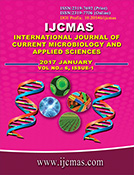


 National Academy of Agricultural Sciences (NAAS)
National Academy of Agricultural Sciences (NAAS)

|
PRINT ISSN : 2319-7692
Online ISSN : 2319-7706 Issues : 12 per year Publisher : Excellent Publishers Email : editorijcmas@gmail.com / submit@ijcmas.com Editor-in-chief: Dr.M.Prakash Index Copernicus ICV 2018: 95.39 NAAS RATING 2020: 5.38 |
Vulvovaginal candidiasis is the name often given to Candida albicans infection of the vagina associated with a dermatitis of the vulva (an itchy rash). ‘Vaginal thrush’, ‘monilia’, and vulvovaginal candidosis are other names used for vulvovaginal candidiasis. About 20% of non-pregnant women aged 15 to 55 harbour Candida albicans in the vagina. Most have no symptoms and it is harmless to them. Overgrowth of Candida albicans causes a heavy white curd-like vaginal discharge, a burning sensation in the vagina and vulva and/or an itchy rash on the vulva and surrounding skin. Oestrogen causes the lining of the vagina to mature and to contain glycogen, a substrate on which Candida albicans thrives. Lack of oestrogen in younger and older women makes vulvovaginal candidiasis much less common. The most common symptom is vaginal itching, which may be severe. Other symptoms include burning with urination, white and thick vaginal discharge that typically does not smell bad, pain with sex, and redness around the vagina. Symptoms often worsen just before a woman's period. Vaginal yeast infections are due to excessive growth of Candida. These yeast are normally present in the vagina in small numbers. It is not classified as a sexually transmitted infection; however, it may occur more often in those who are frequently sexually active. Risk factors include taking antibiotics, pregnancy, diabetes, and HIV/AIDS. Eating a diet high in simple sugar may also play a role. Tight clothing, type of underwear, and personal hygiene do not appear to be factors. Diagnosis is by testing a sample of vaginal discharge. As symptoms are similar to that of the sexually transmitted infections, chlamydia and gonorrhea, testing may be recommended. About 75% of women have at least one vaginal yeast infection at some point in their lives while nearly half have at least two. About 5% have more than three infections in a single year. It is the second most common cause of vaginal inflammation after bacterial vaginosis.
 |
 |
 |
 |
 |